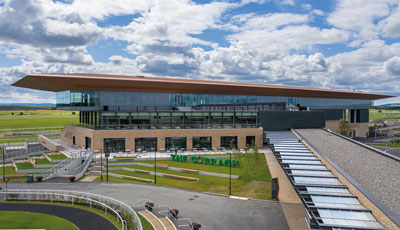SSDA Awards
Award: The Curragh Racecourse Redevelopment, Kildare
 A grandstand with a dramatic cantilevering roof is the centrepiece of a wider racecourse redevelopment masterplan.
A grandstand with a dramatic cantilevering roof is the centrepiece of a wider racecourse redevelopment masterplan.
FACT FILE
Architect: Grimshaw Architects
Structural engineer: AECOM
Steelwork contractor: Kiernan Structural Steel Ltd
Main contractor: John Sisk & Son
Client: The Curragh Racecourse LtdThe Curragh is one of the world’s most famous racecourses and said to be the spiritual home of flat racing in Ireland.
To maintain its competitive position as one of the top racing venues, a redevelopment of the site has been undertaken to meet anticipated future demands.
At the heart of the masterplan is a new grandstand, whose design had to respond to the site’s unique context in an elegant, yet unobtrusive style. In its formal expression, the new grandstand is comprised of stacked horizontal forms, crowned with a dramatic soaring cantilever roof that recognises the planar landscape in which it is set.
According to project architect Grimshaw, the dramatic 7,200m² cantilever roof design was key to creating the architectural vision, with the envelope surfaces tuned to mask the depth of the structure and create a gravity-defying illusion with cantilever spans ranging from 27m in the central area to 45m in the double-cantilevered corners.
The roof structure, supported on the exposed precast concrete grandstand frame below, consists of a regular arrangement of steel cantilever trusses tapering into open plated sections at the tips to create the razor-sharp leading edge as well as simplifying fabrication. Additional spine trusses follow the diagonal hip line of the roof corners, creating a two-way lattice frame with optimised planar geometry.
AECOM Project Engineer Michael Orr says the main challenge for the Curragh Racecourse was the design of the steelwork forming the doubly cantilevered roof and specifically the detail design and fabrication of the complex three-dimensional nodes supporting the dramatic overhangs.
“The nodes, and their interfaces with the exposed concrete structure below, required intensive collaboration between AECOM’s designers and the steel fabricators to resist the high concentrations of load from the two-way spanning structure, and to ensure all tolerances and pre-setting requirements could be achieved. This allowed the sharp leading edge of the roof to be perfectly aligned after de-propping.”
 The roof design also allowed the MEP plant to be concealed within the roof space with no detriment to the overall form. The result is a total steelwork mass of approximately 115 kg/m² for the majority of the roof area.
The roof design also allowed the MEP plant to be concealed within the roof space with no detriment to the overall form. The result is a total steelwork mass of approximately 115 kg/m² for the majority of the roof area.
Integrating the structural solution with the building envelope was also key to the success of realising the team’s mutual vision. For the long-span double-clad roof AECOM’s structural engineers and façade engineers worked hand-in-hand to deliver a holistic design solution, minimising the overall quantities of structural steelwork by ensuring all steel surfaces were fully coordinated with the cladding fixing requirements. This included integrating with the MEP, lighting and rainwater collection systems without compromising the structural or visual integrity.
“Structural steelwork was used as it was the only cost-effective solution that could meet the demands of the design, in terms of achieving structural performance and creating the architectural drama of the slender cantilevered roof,” adds Mr Orr.
The benefits of steel also extended to the use of modular truss components. These were used where possible and maximised the benefits of offsite fabrication, allowing for flexibility in the construction sequence, meaning that the adjacent racecourse could remain operational during the construction works; both for training and a full summer race season; and provided good site tolerance for the installation of the roof finishes to create the seamless continuity of the envelope.
Meanwhile, the copper colour of the roof is said to reference the rural, Irish vernacular and agricultural heritage of Kildare, while the contemporary panelled roof structure, comprised of aluminium sinusoidal panels, provides a striking yet empathetic appearance amidst the rolling countryside. Drawing on a palette of neutral tones, the range of material finishes to the buildings consciously link to the local flora, geology and the traditional rural architectural of its setting.
The Racecourse is designed around the movement and flow between the parade rings, the betting and hospitality areas, and the racetrack, with each of the public spaces designed to have a distinctive atmosphere and identity that celebrate the spectacle of racing. The design creates flexible spaces that can be utilised by the racecourse throughout the year to generate revenue outside of racing.
There was a desire to adopt a genuinely positive approach to sustainability, and the focus was on lean design and the intelligent use of materials including cement replacements, recycled steel, and the adoption of rainwater attenuation and rainwater harvesting as part of a sustainable drainage system. Natural ventilation utilises the exposed thermal mass of the frame internally and is supplemented by smart sensors, actuators and efficient systems design to minimise the building’s energy use.
The structure supports high performance glazing systems to maximise daylight to the main public spaces. A fully integrated access and maintenance strategy was developed with the design team to ensure all aspects of the building fabric can be accessed and maintained as required. The use of high-performance protective coatings and finishes ensured a durable and robust product.
The judges say, a blade-like aerofoil roof is now the dramatic centrepiece to this open landscape and world-famous sporting venue. Behind this bold architectural statement lies a highly-accomplished level of detailed design, precise fabrication, and accurate construction to the most demanding of tolerance requirements. A great team effort.








